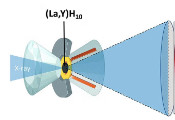Quantum Physics: Describing Chaotic Systems
September 2, 2024 -- Although systems consisting of many interacting small particles can be highly complex and chaotic, some can nonetheless be described using simple theories. Does this also pertain to the world of quantum physics? A research team led by Professor Monika Aidelsburger and Professor Immanuel Bloch from the LMU Faculty of Physics investigated this question concerning quantum many-body systems and found indications that they can be described macroscopically through simple diffusion equations with random noise. The study was recently published in the journal Nature Physics.
“If you want to describe the flow behavior of water, you don’t need to start with the physics of the water molecules. Instead, you can formulate flow equations and analyze the problem on a purely macroscopic basis,” explains Julian Wienand, doctoral candidate in Immanuel Bloch’s research team and lead author of the new study. This approach is known as hydrodynamics. However, when we observe the motion of small particles in water, we see that they are not only carried with the flow, but also make small erratic movements known as Brownian motion.
These fluctuations are a direct consequence of the random collisions of the particles with individual water molecules. “Because these erratic movements are random, we can describe them as white noise and hydrodynamics becomes fluctuating hydrodynamics (FHD),” says Wienand. “Remarkably, this FHD theory tells us that, under certain circumstances, the entire behavior of a system may be determined by a single quantity: the diffusion constant – even though the physics are very complex and chaotic at the microscopic level.” This greatly simplifies the macroscopic description of such systems and obviates the need to engage with a description of the particles’ microscopic interactions.
It is suspected that chaotic systems could generally be described by FHD. But whether and to what extent this also holds true for chaotic quantum systems remains largely an open question. The laws of physics that determine how quantum particles interact are fundamentally different from those governing classical particles and are characterized by phenomena like “uncertainty” and “entanglement,” which defy everyday intuition. At the same time, quantum systems are even more difficult to calculate and could, therefore, particularly benefit from an FHD description.
The research team pursued this question by studying the behavior of chaotic many-body quantum systems under the microscope. In order to observe dynamics, the team prepared a quantum system of ultracold cesium atoms in optical lattices in a non-equilibrium initial state and then let it evolve freely. “The high resolution of our imaging system allows us to measure not only the average density of the particles in the lattice sites, but also their fluctuations,” says Wienand. “Thus, we were able to measure how the fluctuations and density correlations grow over time and conclude that FHD describes our system both qualitatively and quantitatively.” The researchers consider this to be an important indication that chaotic quantum systems, despite their microscopic complexity, can be described simply as a macroscopic diffusion process – similar to Brownian motion.




































